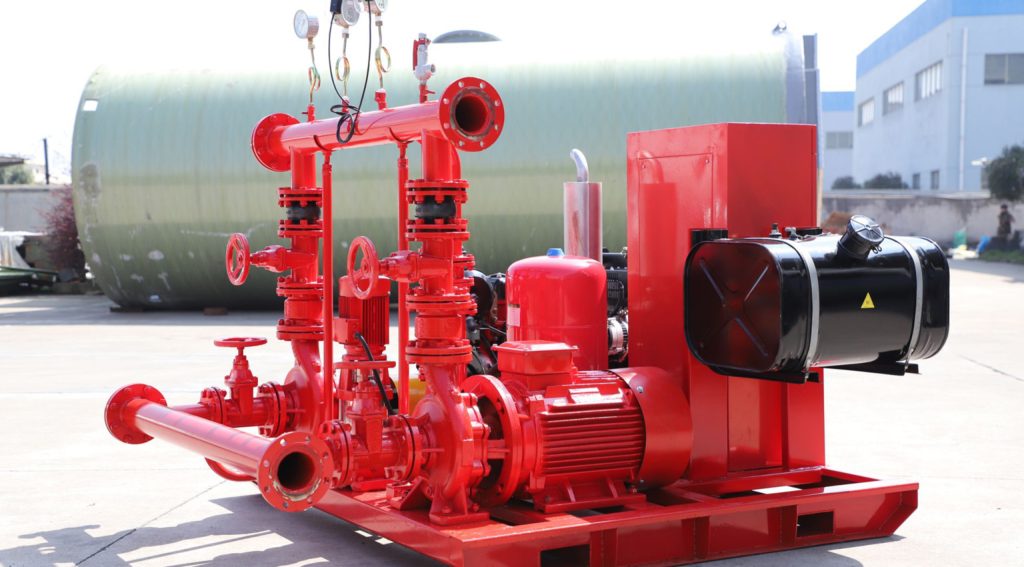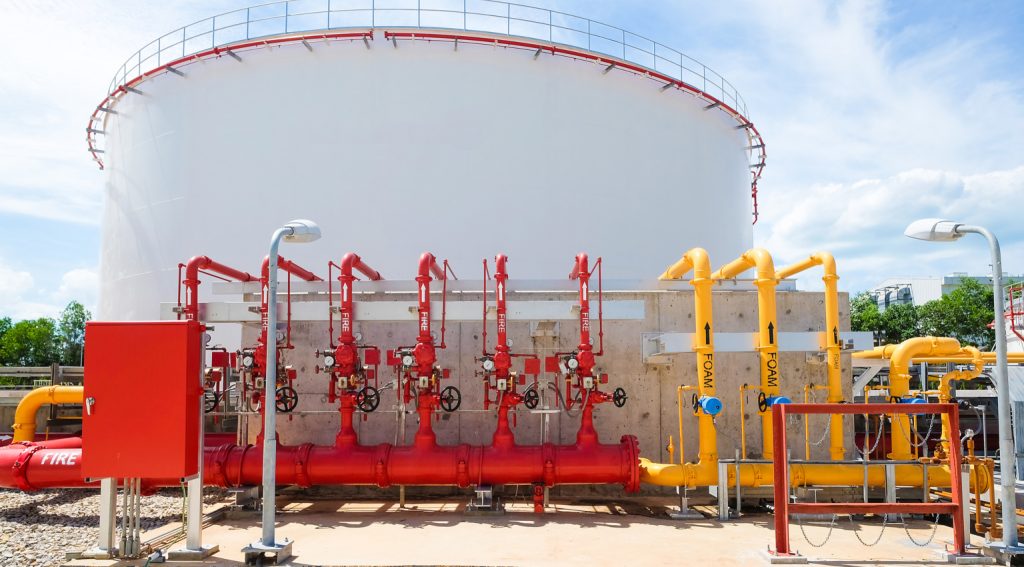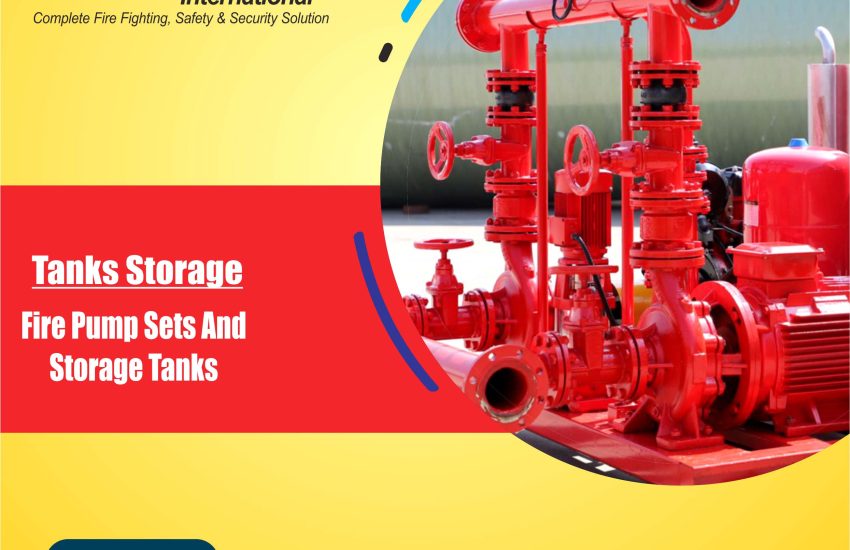Fire Pump Sets And Storage Tanks In any fire safety system, fire pump sets and storage tanks play a critical role in providing the necessary water supply for firefighting operations. These components are essential for maintaining pressure, flow, and water availability during emergencies. This article offers a detailed guide on fire pump sets and storage tanks, explaining their importance, types, installation, maintenance, and more. It aims to help businesses and property owners understand these systems better and how to comply with fire safety regulations.
What Are Fire Pump Sets?

A fire pump set is a specialized device that pumps water into a building’s fire suppression system. It ensures the required pressure and flow rate to fight fires in high-rise buildings, industrial sites, commercial properties, and other large infrastructures. Fire pumps usually run on electric motors, diesel engines, or steam turbines, and they are designed to perform under extreme conditions during emergencies.
Key Features of Fire Pump Sets:
- High Pressure & Flow Capacity: These pumps supply the required pressure and flow rate to support fire sprinklers, hydrants, and other firefighting equipment.
- Reliability: Fire pump sets work efficiently, even during power outages or extreme conditions.
- Compliance with Standards: Fire pump sets must meet national and international fire safety standards, including those set by the NFPA (National Fire Protection Association) and UL (Underwriters Laboratories).
Types of Fire Pump Sets
Several types of fire pump sets serve different requirements. These include:
- Electric Fire Pump Sets:
- Powered by electricity, these pumps work well in buildings with a reliable power source.
- They are suitable for low-risk areas or where electrical backup is available.
- Diesel Fire Pump Sets:
- These pumps run on diesel engines, making them ideal for areas where electricity is unreliable or unavailable.
- Diesel-powered fire pumps are more robust, especially for remote or off-grid locations.
- Steam Fire Pump Sets:
- Typically found in older buildings or industrial sites, these pumps run on steam engines but are less common today.
- Jockey Pumps:
- Smaller pumps maintain pressure in the fire sprinkler system until the main fire pump activates.
- Jockey pumps prevent the main fire pump from cycling unnecessarily.
What Are Fire Storage Tanks?

A fire storage tank is a large water storage system that ensures an adequate water supply for firefighting. These tanks are often located on-site and can be filled from a municipal supply or natural sources. When a fire occurs, water from these storage tanks flows to the fire pump set to provide pressure to the fire suppression system.
Types of Fire Storage Tanks:
- Above-Ground Storage Tanks:
- These tanks are easy to install and maintain. You often find them in urban environments, and they can hold large amounts of water.
- Made of steel, fiberglass, or concrete, they may require protective coatings to prevent rust.
- Underground Storage Tanks:
- These tanks are buried beneath the ground and are ideal for areas where space is limited.
- Typically constructed of steel or concrete, they are designed to withstand external pressures.
- Bladder Tanks:
- Flexible tanks made of durable fabric, bladder tanks are suitable for temporary installations or areas with irregular water requirements.
- Pressurized Water Tanks:
- These high-pressure systems provide immediate water supply under pressure to fire pumps and sprinklers.
Why Are Fire Pump Sets and Storage Tanks Essential in Fire Safety Systems?
Having a fire pump set and fire storage tank is crucial for several reasons:
- Ensures an Adequate Water Supply: During a fire emergency, you need a reliable water source that can be pumped at the required pressure to suppress the fire.
- Compliance with Local Regulations: Many fire safety codes and regulations require fire pumps and storage tanks for buildings over a certain height or size.
- Prevents Fire Spread: By efficiently delivering water to the fire suppression system, these components help minimize damage by controlling or extinguishing the fire.
- Reduces Emergency Response Time: An automated fire pump and storage tank system can significantly reduce the time it takes to control the fire.
How to Install Fire Pump Sets and Storage Tanks
- Assessment and Design:
- A professional fire safety consultant evaluates your property to determine the required water flow and pressure for your building.
- Based on this assessment, they will select the appropriate fire pump set and storage tank sizes and capacities.
- Fire Pump Set Installation:
- Professionals must install fire pump sets according to fire safety standards, ensuring proper alignment and secure mounting.
- Additionally, they will ensure that all electrical and mechanical connections are secure, allowing the fire pump to work efficiently in an emergency.
- Fire Storage Tank Installation:
- Depending on the tank type, installation may involve excavation (for underground tanks) or placing a sturdy foundation (for above-ground tanks).
- The storage tanks must connect to a reliable water source, and appropriate safety measures must prevent contamination.
- System Testing and Commissioning:
- After installation, the fire pump and storage tank undergo rigorous testing to ensure they meet performance standards and can handle fire emergency scenarios.
- Testing includes flow tests, pressure tests, and verifying that the system works properly with other fire safety equipment, such as alarms and sprinklers.
Maintaining Fire Pump Sets and Storage Tanks
Regular maintenance ensures that your fire pump set and storage tank continue to operate efficiently. Here’s a basic checklist:
- Fire Pump Set Maintenance:
- Inspect the motor: Check for proper lubrication and potential electrical issues.
- Test the pressure and flow: Ensure the pump can deliver the required pressure and flow rate.
- Check for leaks: Inspect connections and seals for leaks, as they can reduce pump performance.
- Clean the pump: Regularly remove dirt and debris to avoid clogs.
- Fire Storage Tank Maintenance:
- Inspect tank integrity: Ensure the tank remains free from cracks, leaks, or rust, which could compromise water storage.
- Check water quality: Monitor and clean the tank regularly to prevent contamination.
- Test the water level and pressure: Make sure that water can be efficiently delivered to the fire suppression system.
How to Choose the Right Fire Pump Set and Storage Tank
When selecting a fire pump set and storage tank, consider these factors:
- Property Size and Type: Larger buildings or industrial facilities may require more powerful fire pumps and larger storage tanks.
- Water Source: Evaluate the availability and reliability of the water source that will supply the fire storage tank.
- Fire Safety Codes: Ensure the system complies with local fire safety regulations and national standards.
- Budget: Consider installation costs, operational costs, and ongoing maintenance when choosing the right equipment.
Conclusion
Fire Pump Sets And Storage Tanks Investing in a reliable fire pump set and storage tank is vital for protecting both life and property during a fire emergency. By selecting the right components, ensuring proper installation, and performing regular maintenance, you can ensure that your fire protection system functions effectively when needed most. Always consult with fire safety professionals to guarantee your system meets required standards and regulations.


